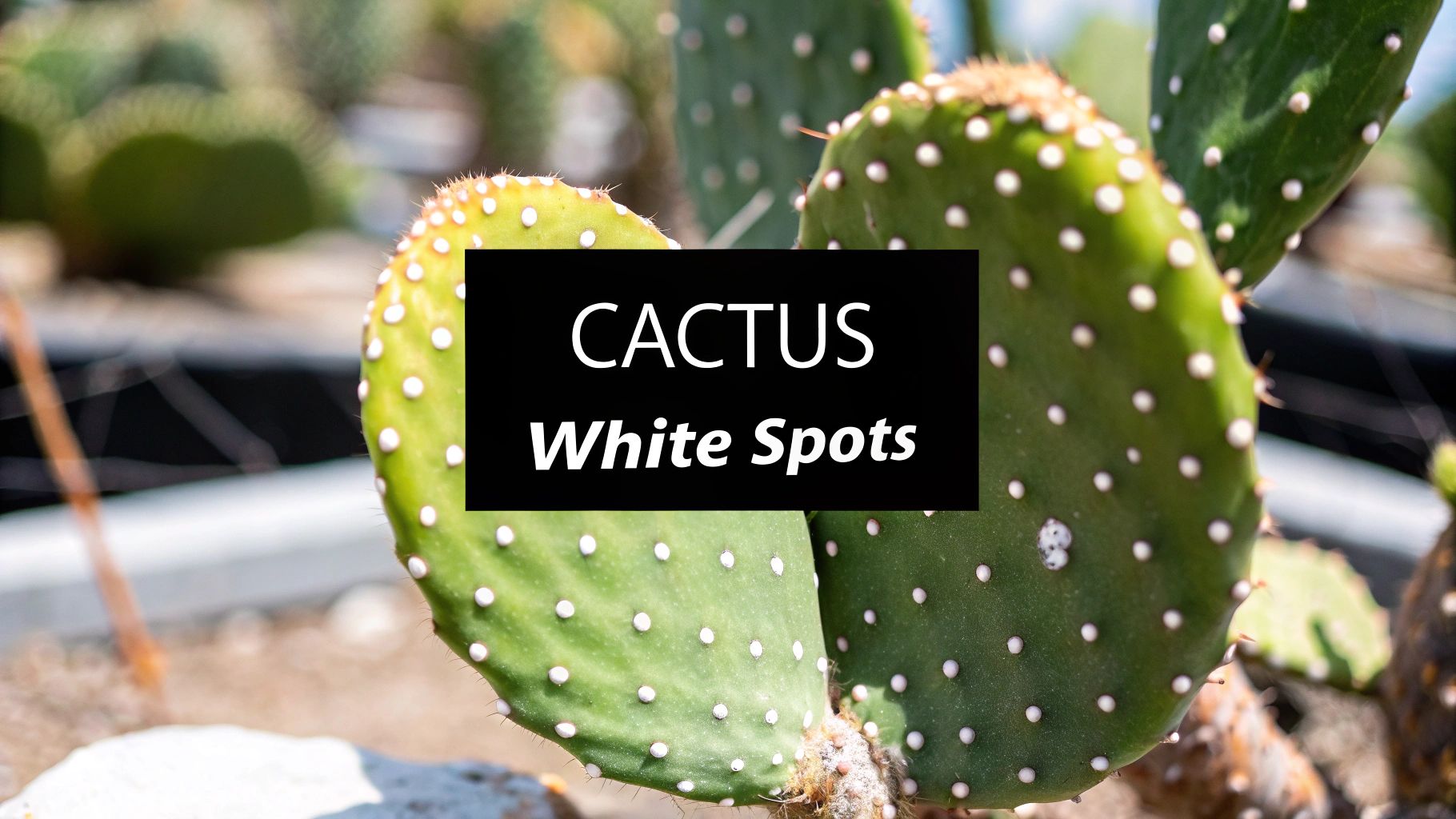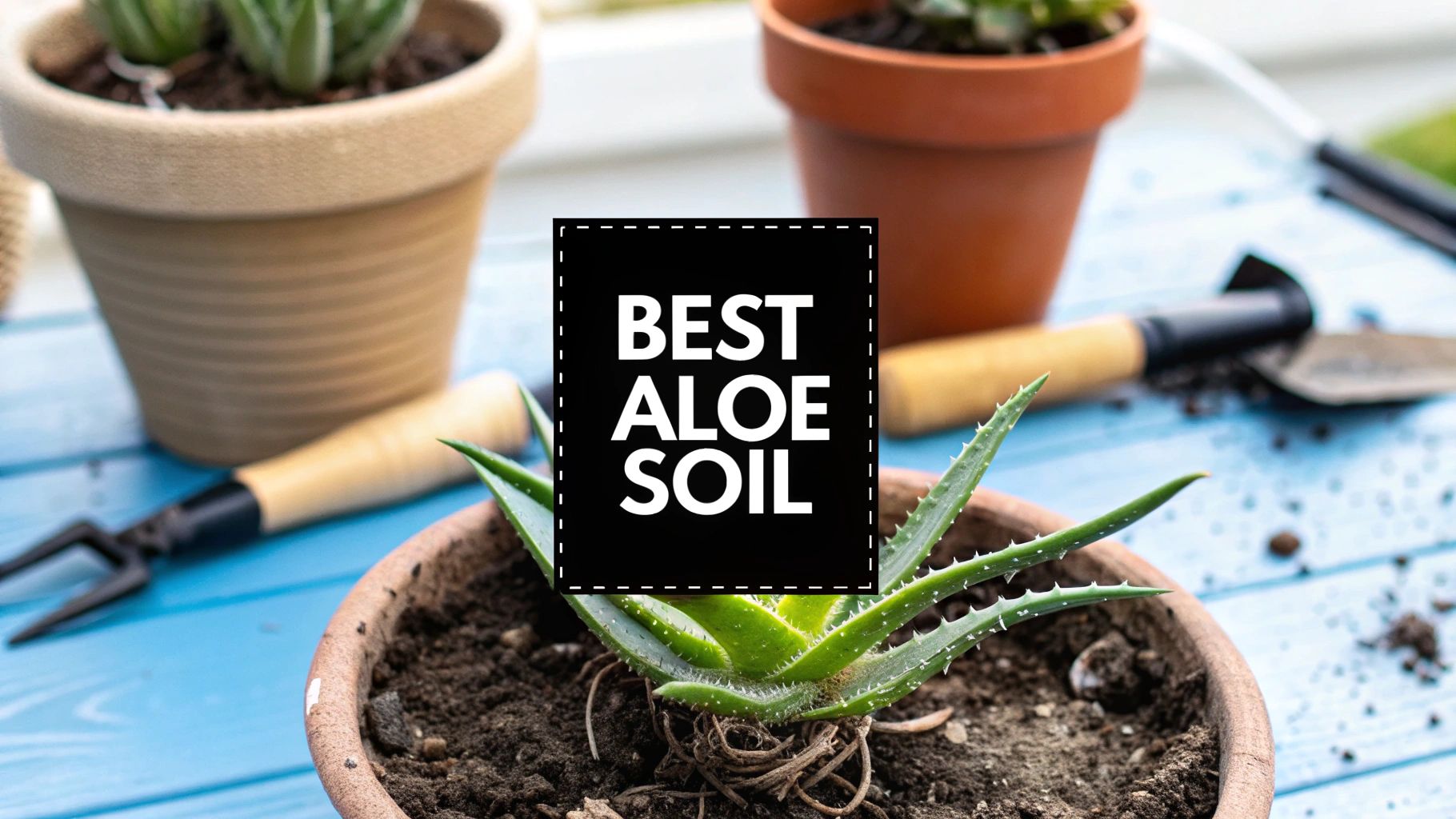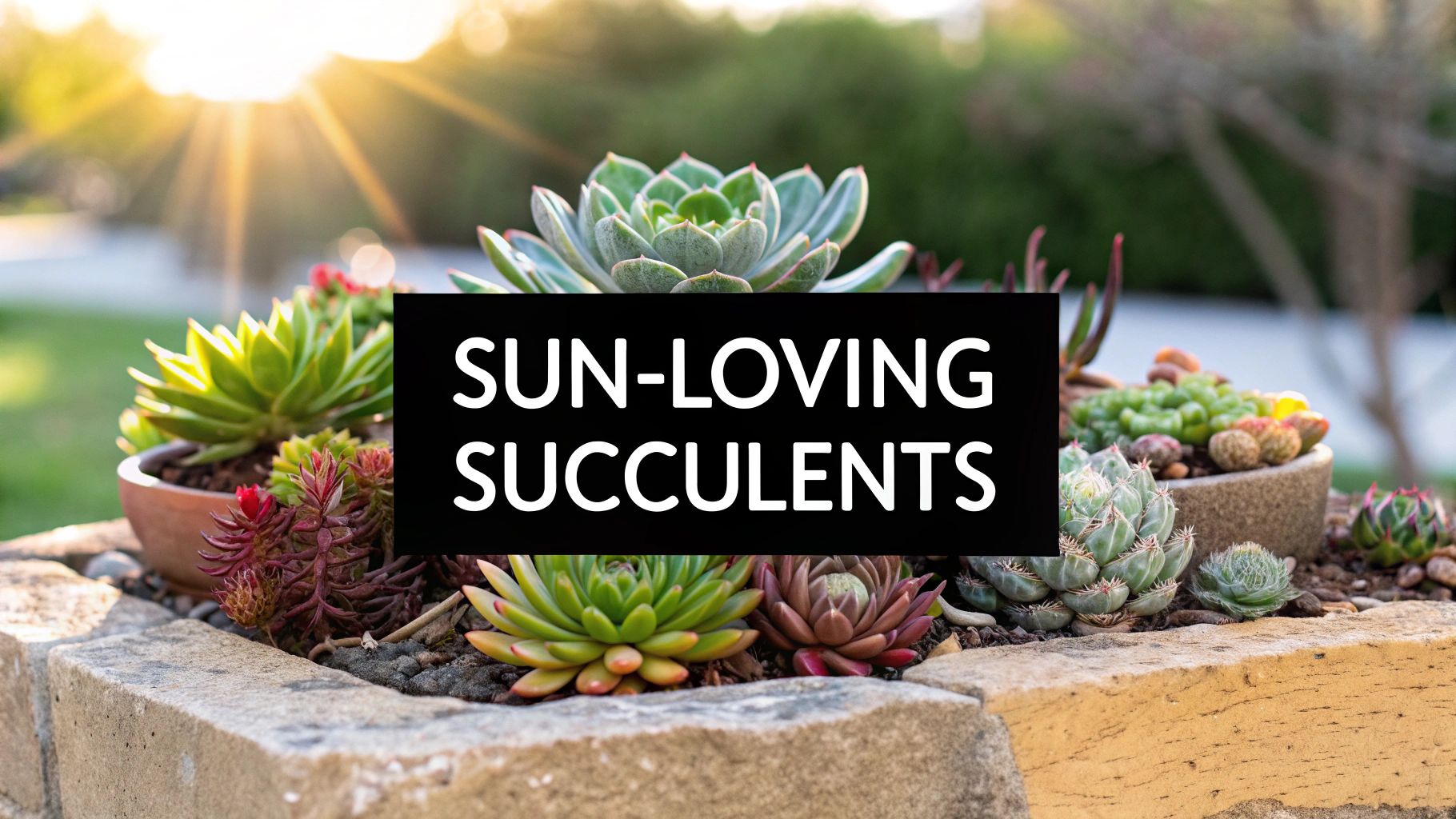Tired of your cacti turning to mush? Let's get one thing straight: if you're watering on a strict schedule, you're probably doing it wrong. The secret to a happy cactus isn't about when you water, but how. Forget those little sips every Sunday. For cacti, it’s all about the "soak and dry" method.
This is the only technique I trust, and it’s surprisingly simple. You just have to mimic what happens in their natural desert habitat: a huge downpour, followed by a long, dry spell.
Why Your Cactus Watering Method Isn't Working
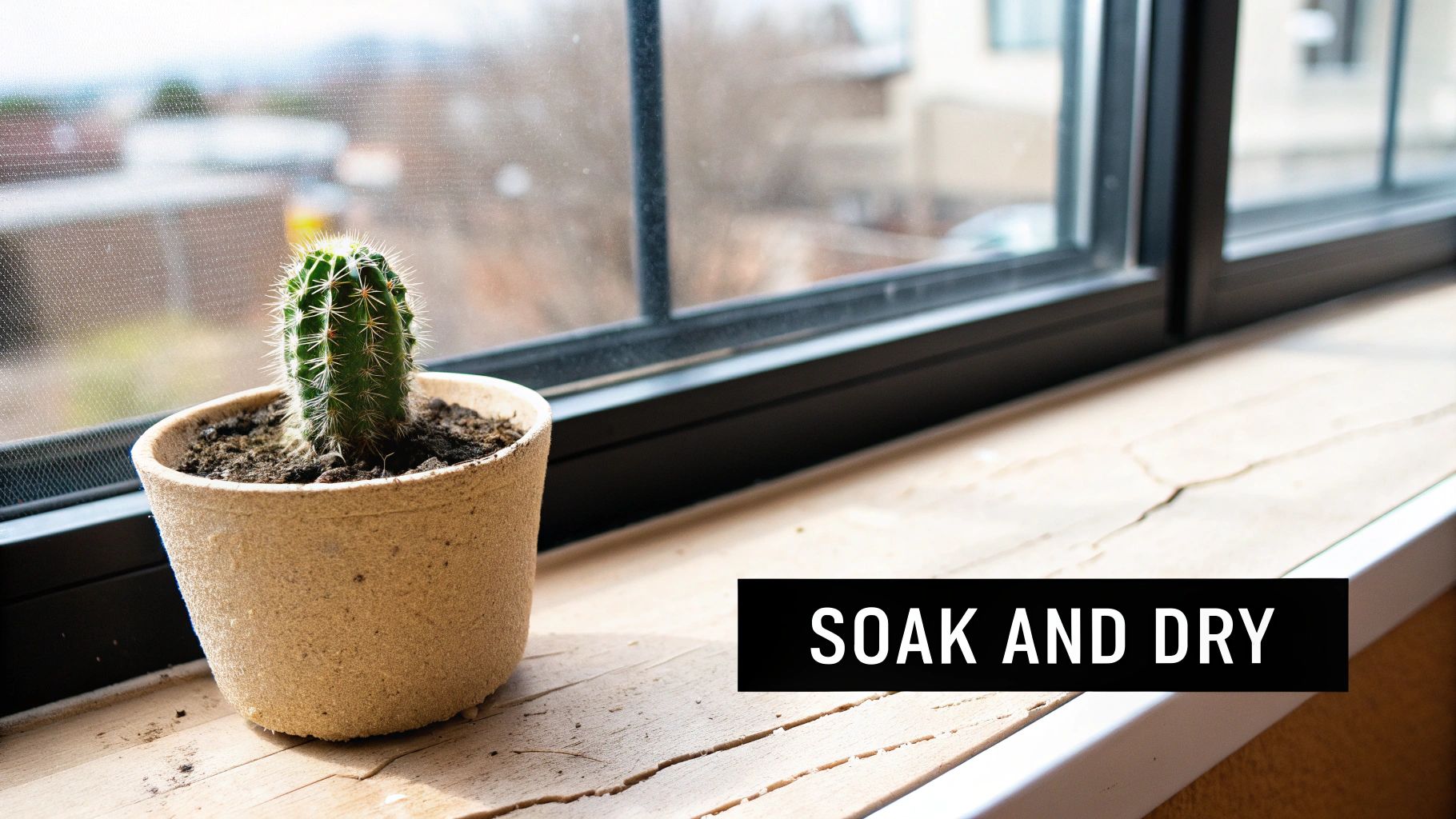
If you’ve lost a cactus before, I’m willing to bet it was from overwatering. So many people treat them like a typical houseplant, giving them small, frequent drinks. This is the absolute fastest way to kill a cactus.
That constant dampness is a death sentence. It encourages weak, shallow roots near the surface and creates the perfect environment for root rot to set in. Cacti are built for drought. Their roots are designed to soak up a ton of water during rare, heavy rains and then survive as the soil dries out completely. Your job is just to recreate that cycle at home.
Shifting From Calendar to Conditions
Throw out the calendar. Seriously. Your cactus's thirst depends entirely on its environment.
A small cactus in a terracotta pot basking in a sunny window will dry out in a fraction of the time it takes a larger plant in a glazed pot in a shadier corner. This is exactly why a rigid schedule fails—it ignores the real-world conditions your plant is living in.
The goal is to let the soil go bone-dry between waterings. Don't be afraid to wait. This forces the roots to grow deep and strong as they search for any lingering moisture, which is exactly what you want.
If you remember only one thing, make it this: It is always, always better to underwater than to overwater. A thirsty cactus will give you signs and can bounce back with a good drink. A cactus with rotted roots is usually a goner.
The Foundation for Success: Soil and Soaking
Before you can even think about the "soak and dry" method, you need the right soil. Standard potting mix is a no-go; it holds onto water for far too long and will suffocate the roots. A well-draining mix is absolutely essential.
For a great breakdown of what to look for, check out this guide on the ideal cactus and succulent soil. Once you have the right soil, you’ve set the stage for success.
Here's a quick rundown of the "soak and dry" philosophy to keep in mind.
Quick Guide to the 'Soak and Dry' Method
| Core Principle | What It Means | Why It Matters |
|---|---|---|
| Soak Thoroughly | When you water, do it deeply. Water until it flows freely from the pot's drainage holes. | This encourages deep root growth and ensures the entire root system gets hydrated, mimicking a desert downpour. |
| Dry Out Completely | Wait until the soil is 100% dry from top to bottom before watering again. This might take weeks. | Cacti roots need to breathe. Letting the soil dry out prevents rot and mimics the natural drought cycle. |
| Check, Don't Guess | Use your finger, a chopstick, or a moisture meter to test the soil deep in the pot. | The top soil can be deceivingly dry while the bottom is still wet. This ensures you only water when needed. |
Pairing the right soil with this watering technique is the game-changer. It creates an environment that lets your cactus not just survive, but truly thrive.
Learning to "Read" Your Cactus
Forget the rigid calendar. The single best skill you can develop is learning to read your cactus's body language. These plants are constantly sending signals, and once you know what to look for, you'll know exactly when they need a drink. It’s a shift from just owning a plant to truly understanding it.
A thirsty cactus will give you a few tell-tale signs. You might notice its skin looks a little wrinkled or puckered, a clear indication that its internal water stores are getting low. Its normally vibrant green color can start to look a bit washed out or dull. Sometimes, the pads or stems will feel soft and a little flexible instead of firm and full. These are the first whispers that it's time for water.
What an Underwatered Cactus Looks Like
Seeing these signs isn't a reason to panic. In fact, it’s a good thing! An underwatered cactus is easy to fix and is a far safer problem to have than the alternative.
- Wrinkled or Shriveling Skin: The body of the plant looks a bit deflated, almost like a grape starting to turn into a raisin.
- A Bit of Softness: If you give a pad or stem a gentle squeeze, it feels less firm and has more give than usual.
- Fading Color: Those deep, healthy greens might look paler or less vibrant.
When you see this, it’s your cue to give it a good, thorough soak. A healthy but thirsty cactus will usually plump right back up in a day or two, which is always a satisfying sight. It really shows you how tough these plants are.
Spotting the Dangers of Overwatering
Now for the serious part. Overwatering is the number one killer of cacti, bar none. While a thirsty plant can almost always be revived, a plant suffering from root rot is often a goner. The real damage happens out of sight, deep in the soil, where soggy conditions suffocate the roots and invite fungal diseases to move in.
If there’s one golden rule for cactus care, it’s this: when in doubt, wait it out. A cactus can bounce back from being too dry, but it can't recover from rotted roots. Your main job is to protect that root system.
The signs of overwatering are less of a whisper and more of a scream for help.
Red Flags: Signs You've Watered Too Much
If you see any of the following, you need to act fast. These aren't subtle hints; they are alarm bells ringing for your plant.
- A Mushy Base: The stem feels soft, squishy, or even unstable right at the soil line. This is the classic, most devastating sign of advanced root rot.
- Yellowing or Browning: The plant's skin turns a sickly, translucent yellow or brown, and this discoloration usually starts from the bottom and creeps its way up.
- A Bad Smell: A sour, rotten odor coming from the soil is a dead giveaway that decay is happening under the surface.
- A Wobbly Plant: The entire cactus might feel loose in its pot or even start to lean, a sign that its root system has disintegrated and can no longer anchor it.
If you catch these signs early, you might have a chance to save the cactus by unpotting it, cutting away all the rotted tissue, and repotting it in fresh, dry soil. But honestly, prevention is your best and only reliable strategy. By paying close attention, you'll learn to give water only when it's needed and, just as importantly, hold back when it’s not.
Mastering the Soak and Dry Watering Technique
This is where the rubber meets the road. The “soak and dry” method isn't some rigid, by-the-book schedule; it's more of an art you develop by listening to your plant. Think of it this way: you're recreating the natural rhythm of the desert—a long drought followed by a torrential downpour. This is exactly what your cactus is built for.
So, how do you know when it’s time? First, you have to be certain the soil is completely dry. And I don’t just mean the top layer, which can fool you by drying out fast while the bottom stays soggy. The old-fashioned finger test is still the most reliable: stick your finger about two inches into the soil. If you feel even a hint of moisture or coolness, do not water. For bigger pots, I like to use a simple wooden chopstick pushed down to the bottom—if it comes out clean and dry, you're good to go.
The Correct Way to Soak Your Cactus
Once you've confirmed the soil is bone-dry, it's soaking time. I recommend taking your cactus right to the sink or even the bathtub. Now, water the soil thoroughly. You want to drench the entire root system, not just give it a little sip. Keep pouring until you see a steady stream of water flowing from the pot’s drainage holes. This deep drink encourages the roots to grow down deep and strong.
This is a critical step that so many people get wrong. Misting a cactus or giving it tiny sips of water is one of the worst things you can do. It only moistens the top inch of soil, which leads to a weak, shallow root system that's incredibly vulnerable.
A deep, thorough soak followed by a complete dry-out period is the absolute foundation of healthy cactus care. This simple rhythm is your best defense against root rot, and it builds a resilient plant that can handle a bit of forgetfulness.
After the big drink, the next step is equally vital: let it drain completely. Let the pot sit for a good 15-20 minutes to make sure every last drop of excess water has escaped. Whatever you do, never let your cactus sit in a saucer full of water. That's a one-way ticket to root rot.
This decision tree infographic is a great visual shortcut for figuring out if your cactus is thirsty or if you've gone too far.
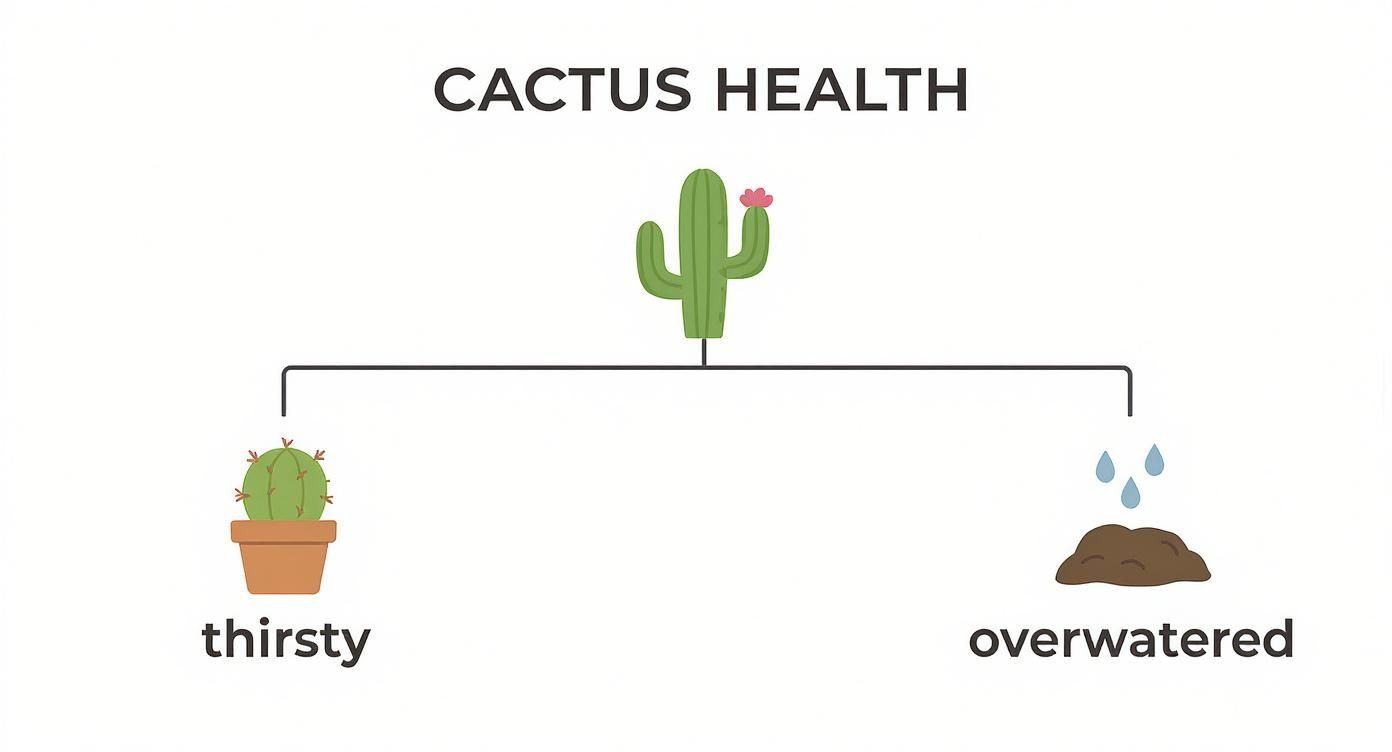
Use it to quickly spot the difference between the tell-tale signs of thirst and the more dangerous symptoms of rot.
Common Watering Mistakes vs Best Practices
It's surprisingly easy to fall into bad watering habits, especially when you're starting out. Recognizing these common pitfalls is the first step to becoming a better plant parent. Many of these core ideas apply to other arid plants, too. If you're curious, you can learn more about how to water succulent plants in our other guide.
To make it crystal clear, I've put together a table comparing some of the most frequent mistakes with the best practices we've just covered.
| Common Mistake | Why It's Harmful | Best Practice |
|---|---|---|
| Watering on a schedule | Ignores what the plant actually needs based on light, humidity, and season. This almost always leads to over or underwatering. | Watering based on soil dryness. Only water when the soil is 100% dry all the way through. |
| Small, frequent sips | Encourages a weak, shallow root system because the water never reaches the bottom of the pot. | Soaking the soil thoroughly. Drench the soil until water freely drains out the bottom, hydrating the entire root ball. |
| Letting it sit in water | Creates a constantly soggy environment around the roots, which is the number one cause of deadly root rot. | Allowing it to drain completely. Always empty the saucer after watering and ensure the pot isn't sitting in a puddle. |
| Watering the plant body | Can cause rot or fungal spots on the cactus's skin, especially if water gets trapped in ridges or crevices. | Watering the soil directly. Aim the water at the soil around the base of the plant, keeping the body dry. |
Avoiding these common mistakes and sticking to the "soak and dry" philosophy will set you—and your cactus—up for long-term success.
How to Adjust Watering for Every Season
Your cactus doesn't live by the same schedule all year long, so your watering can shouldn't either. The real secret to mastering cactus care is learning to sync up with its natural rhythm—the difference between its active growing season and its all-important rest period.
Spring and summer are when your cactus is really in its element. It's busy pushing out new growth, whether that's new pads, flowers, or just getting taller. All that activity takes a lot of energy, which means it needs more water. You’ll notice the soil dries out much faster during these warmer, brighter months. I find myself watering most of my collection every 2 to 4 weeks, though it always depends on the specific plant and pot.
This is the time to really pay attention. The combination of more daylight and higher temperatures sends its metabolism into overdrive. This is precisely why the "soak and dry" method works so well; you're giving it a big drink right when it's ready to put that fuel to work.
Embracing Winter Dormancy
Once fall rolls around and the days get shorter, you'll see your cactus start to slow down. This is the beginning of its winter dormancy, which is basically a hibernation period for plants. Its growth grinds to a halt, and its need for water drops dramatically. This is, without a doubt, the time when most well-meaning cactus owners accidentally kill their plants with kindness—by overwatering.
Since the plant isn’t actively growing, it's just not using much moisture. If you keep watering on a summer schedule, the roots will be stuck in cold, damp soil, which is a fast track to root rot. For many of my cacti, I might only water them once every 6 to 8 weeks through the winter, and sometimes even less than that.
Key Takeaway: Winter is a time for observation, not action. The soil is going to stay damp for a long time. Your main job is to fight the urge to water and just let your cactus rest.
A Note on Cold-Hardy Cacti
It's worth mentioning that some cacti are incredibly tough and can handle the cold. Species like certain types of Opuntia (Prickly Pear) can survive freezing temperatures, but their winter care is a bit different. For a deeper dive, you can check out our guide on cactus that can survive winter to learn their specific requirements. But even for these rugged survivors, cutting back on water is absolutely critical.
Here’s a simple seasonal cheat sheet I use:
- Spring (The Gradual Wake-Up): As the days get longer and warmer, I slowly start watering a little more often. I let the soil tell me when it’s ready, as it will start drying out faster.
- Summer (Peak Growth): Water deeply whenever the soil is bone dry. This is when your cactus is the thirstiest and doing most of its growing for the year.
- Fall (Winding Down): I start tapering off the watering. As the light fades and temperatures drop, I stretch the time between waterings.
- Winter (Deep Rest): Water becomes a rare event. The goal is just to keep the roots from completely drying out, not to trigger any new growth.
At the end of the day, use the seasons as your general guide, but always let the soil have the final say.
Creating the Ideal Environment for Your Cactus
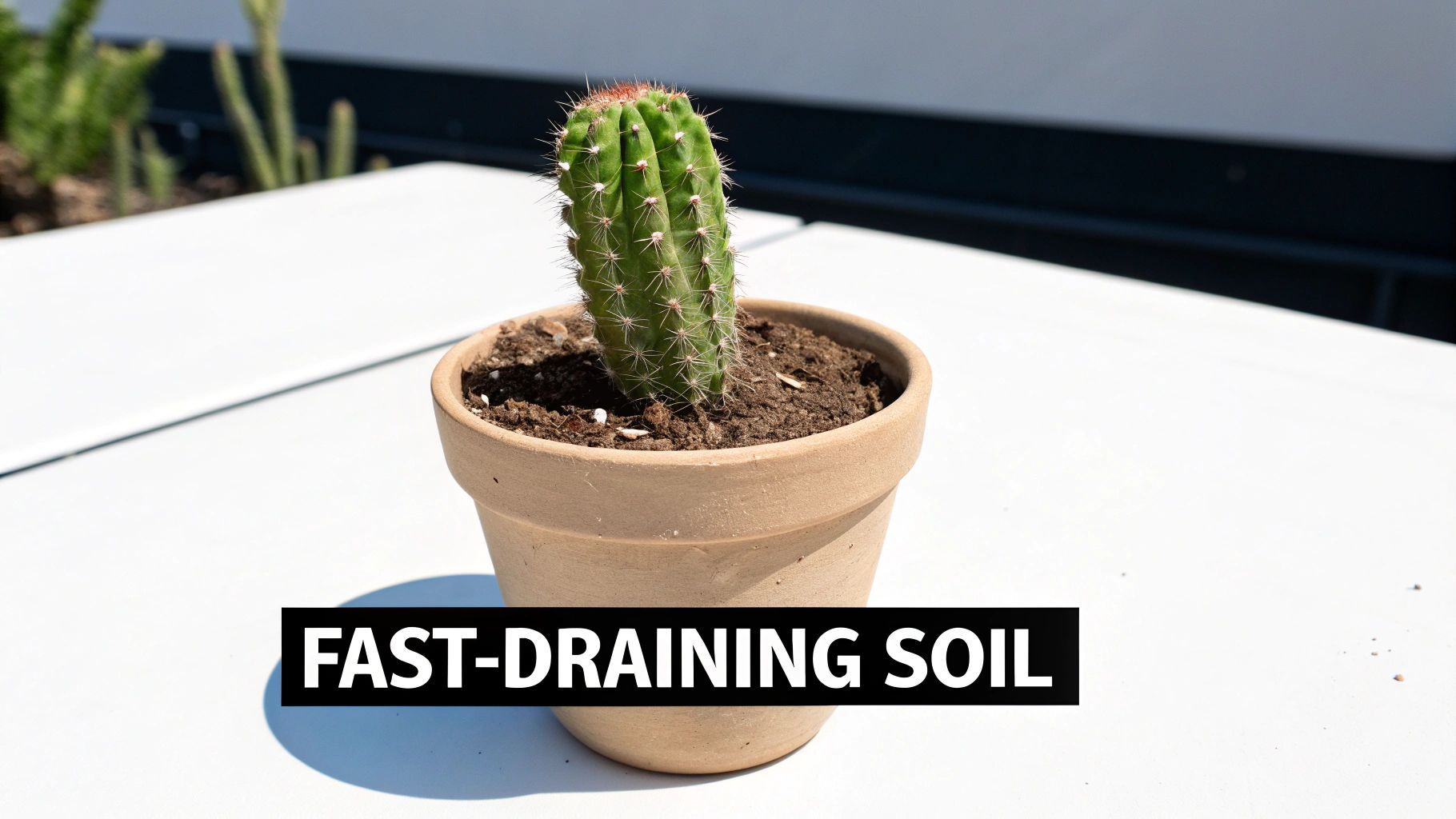
Mastering your watering schedule is crucial, but it’s only one piece of the puzzle. If your cactus is stuck in a bad environment, even the most perfect watering routine can end in failure. It helps to think of your watering habits and the plant’s home as a partnership—when one part isn't working, the whole system breaks down.
To truly succeed with cactus care, you have to build the right foundation first. This means setting up an environment that works with your watering efforts, creating a buffer for the occasional mistake and giving your cactus the quick-drying conditions it craves.
Why Your Soil Choice Is Everything
The single biggest mistake I see people make is using the wrong soil. Standard potting mix is a death sentence for a cactus. It’s designed to hold moisture like a sponge, which is great for a fern but terrible for a desert plant. This dense, soggy soil suffocates the roots and becomes a breeding ground for rot.
You need a proper cactus mix that is gritty, airy, and built for sharp drainage. It shouldn't compact over time. Instead, it lets water rush through freely, giving the roots a quick drink before it disappears. This kind of soil is your best insurance policy against overwatering because it makes it incredibly difficult for the roots to stay wet for too long.
Your soil should do the hard work for you. A fast-draining mix is a forgiving one, creating an environment where excess water can escape quickly, dramatically reducing the risk of root rot.
Light Dictates Thirst
Light is the engine that powers your cactus’s growth, and by extension, its thirst. Imagine a cactus basking in a bright, south-facing window. It's getting hours of intense sun, actively photosynthesizing and using up water to fuel its processes. The sun's heat also helps bake the soil dry. This plant will need water much more often.
Now, picture another cactus in a dim corner or on a north-facing windowsill. Its metabolism is practically crawling. Since it isn't growing much, its need for water is drastically lower. If you watered both of these cacti on the same schedule, the one in low light would be a goner. You have to tailor your watering frequency to match the light your plant gets.
The Power of the Right Pot
Finally, don't overlook the pot itself. Those beautiful glazed ceramic or plastic pots look great, but they are non-porous and trap moisture inside. If you’re just starting out, they can be a bit of a gamble.
Terra cotta is a cactus-lover’s best friend. I recommend it to everyone for a few simple reasons:
- Breathability: The porous clay lets air and water move right through the walls, helping the soil dry out faster and more evenly.
- Moisture Wicking: It literally pulls excess moisture away from the root ball, which is exactly what a happy cactus wants.
No matter which pot material you go with, there is one feature that is absolutely non-negotiable: drainage holes. A pot without drainage is a bathtub, and your cactus will drown. It's that simple.
Also, consider your water quality. Hard water can cause mineral buildup in the soil over time. In some cases, looking into water softening solutions can make a real difference for the long-term health of your plants. By getting the soil, light, and pot right, you create a resilient ecosystem where your cactus can truly thrive.
Got More Cactus Watering Questions? Let's Dig In.
Even the most seasoned cactus owner hits a snag now and then. You think you have the routine down, but a specific situation pops up and makes you pause. Let's tackle some of those common "what-if" scenarios so you can water with total confidence.
Is Tap Water Okay for My Cactus?
For the most part, yes. Your everyday tap water will do the job just fine. Cacti are tough and generally aren't too picky.
The one exception is if you know you have extremely hard water, which is loaded with minerals. Over time, you might start seeing a white, crusty film on the soil's surface or around the rim of the pot. This isn't an emergency, but those minerals can gradually alter the soil's chemistry.
If you're worried about it or your cactus just seems a bit "off," you've got a few easy workarounds:
- Let your water sit out. The simplest trick in the book. Fill your watering can and just leave it on the counter overnight. This gives chlorine a chance to evaporate before it ever reaches your plant.
- Switch to filtered or distilled. If you have a particularly special or sensitive cactus, using filtered water from your fridge or grabbing a jug of distilled water is a foolproof way to avoid mineral buildup entirely.
- Collect rainwater. This is the gold standard. Rainwater is naturally soft and free of the additives found in tap water. It's exactly what cacti would get in their natural habitat.
Should I Water a Cactus Right After Repotting?
This is a great question, and getting it wrong is one of the most common mistakes I see. The answer is an emphatic no, you shouldn't.
When you move a cactus to a new pot, its fine, delicate roots are bound to get a little banged up. Some will be bruised, and others might even break. If you pour water into that situation, you're essentially soaking open wounds, creating the perfect environment for rot to take hold before the plant can even begin to recover.
Expert Tip: Give a newly repotted cactus at least one full week to settle in before you even think about watering it. For bigger plants with more extensive root systems, I'd even push that to two weeks. This dry period is crucial; it gives all those little root injuries time to callous over and heal, protecting your plant from a nasty infection.
A little patience here goes a long way in setting your cactus up for success in its new home.
How Can I Tell if My Pot Drains Well Enough?
Good drainage is everything for a cactus, and it's more than just having a hole in the bottom of the pot. A truly well-draining pot has a hole (or several) that's big enough for water to escape quickly without soil clogging it up.
Here's the real test: when you water your plant, you should see excess water starting to flow out the bottom within a matter of seconds.
If you notice water pooling on the surface for a while or it just seems to take forever to drain through, that’s a major red flag. It could mean the drainage hole is too tiny, but more often than not, it points to a soil mix that's too dense and is retaining far too much moisture. The whole point of watering a cactus is to moisten the roots, not drown them.
At The Cactus Outlet, we believe the right plant can completely change the feel of a room. Check out our collection of vibrant, healthy cacti and find your next spiky friend today.


